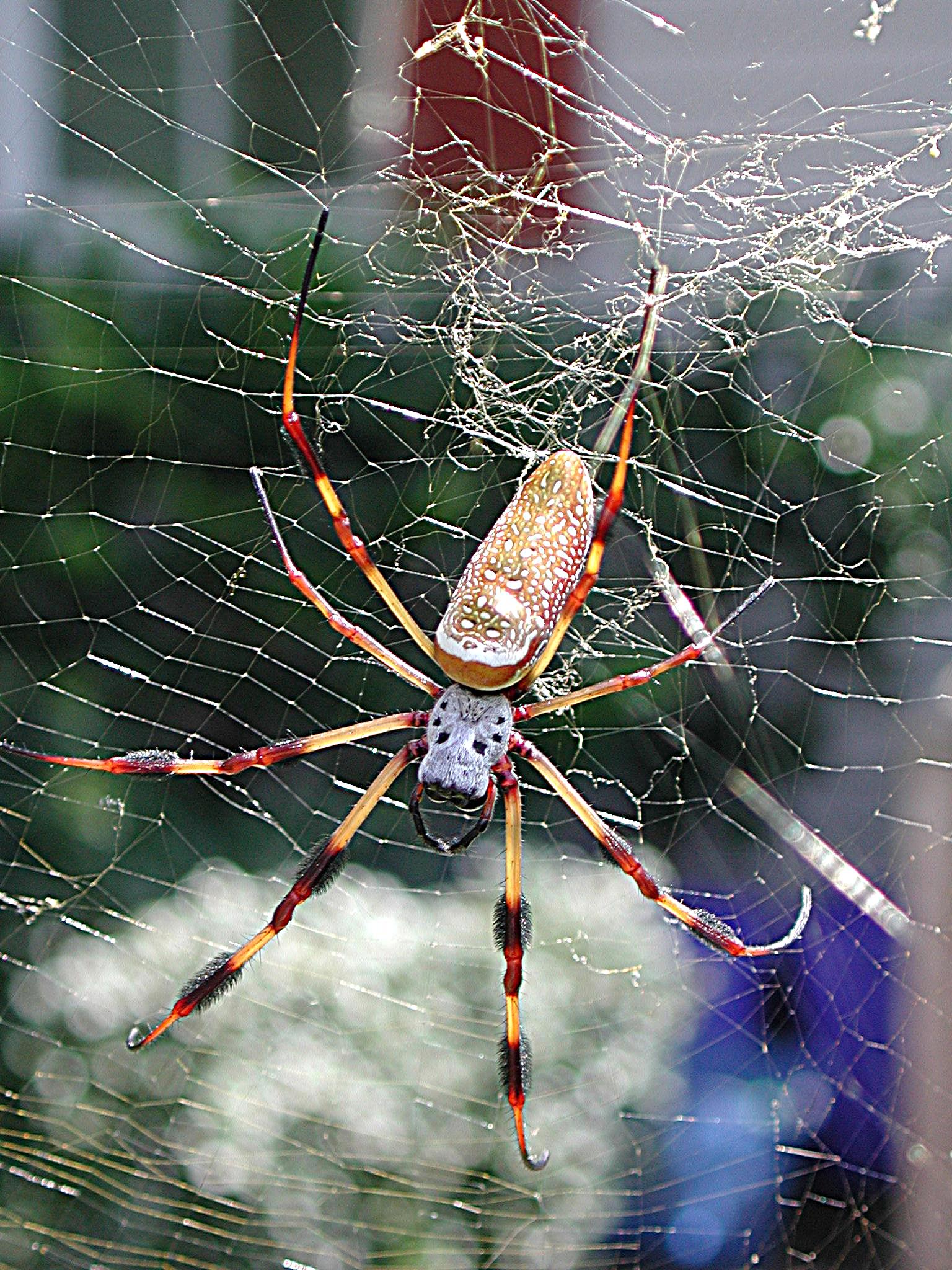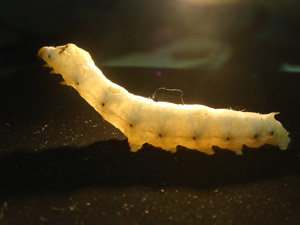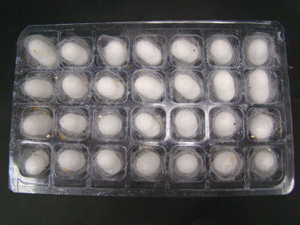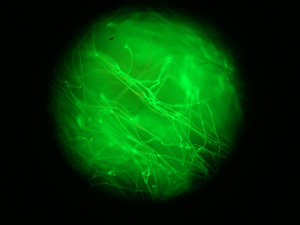Seda transgénica gusano/arácnida está por ser lanzada al mercado
Silk produced by transgenically engineered silkworms exhibits the highly sought-after strength and elasticity of spider silk.

Gusanos producen seda arácnida
Gusanos de seda que fabrican capullos con proteínas de araña fueron creados por investigadores estadounidenses para aprovechar ‘hilos’ más delgados y de mayor resistencia para suturas quirurgicas. Otras aplicaciones estarían en prótesis, mejores vendas o fibras para reparar o reemplazar tendones o ligamentos dañados. Entre las aplicaciones no medicas se tendría paracaídas más ligeros y fuertes.
Uno de los investigadores, Donald Jarvis, de la Universidad de Wyoming explicó que estos gusanos son biologicamente normales y cumplen su metamorfosis en polillas de la manera usual, lo único diferente es que producen capullos con fibras más resistentes: “Cada gusano de seda transgénico recibió un nuevo gen que codifica una proteína similar a la de las telarañas, además de otro gen que le da un color diferente para identificar a simple vista el producto modificado”.
La idea de crear estos animalitos quiméricoss surgió en 1997, ya que los hilos producidos por las arañas son más elásticos y resistentes que los de los gusanos de seda. El problema es que las arañas son animales sumamente territoriales y caníbales, lo que hace su “crianza” algo casi imposible para la industria.
Hacia 2008, Jarvis tomó los genes A2S814 y (GPGGA)8 de la araña sudamericana Nephila clavipes, mejor conocida como araña de seda de oro, los cuales están vinculados directamente con la elasticidad y fuerza, y los colocó en huevos de gusano de seda común (Bombyx mori).
“Si medimos la resistencia de un hilo de seda del 1 al 100, podríamos decir que la del gusano de seda normal tiene una resistencia de 43, mientras que el gusano de seda transgénico tiene una resistencia de 86, es decir, el doble”, precisó el investigador.
.
La seda de araña tiene un enorme potencial como biomaterial para aplicaciones muy diversas, de las cuales, la industria médica sería la primera beneficiada, pero hasta ahora los obstáculos para su “cultivo” han sido grandes. Las proteínas de la telaraña ya habían sido colocadas en bacterias transgénicas, levadura, algunas plantas, insectos y células de mamíferos, pero sin ningún resultado positivo. También se había ensayado previamente la incorporación de las proteínas de la araña a las fibras de los gusanos, pero basados en proteínas quiméricas, en proteínas de ingeniería molecular, lo que tuvo un éxito parcial.
.
 http://frank.itlab.us/spider_2002/large/nephila_clavipes.jpg
http://frank.itlab.us/spider_2002/large/nephila_clavipes.jpg

.
Seda mejorada híbrida de gusano y araña
ScienceDaily (6 de enero de 2012) - La investigación publicada esta semana muestra que la seda producida por ingeniería transgénica en gusanos de seda en el laboratorio de Malcolm Fraser Jr., profesor de ciencias biológicas en la Universidad de Notre Dame, exhibe la codiciada fuerza y elasticidad de la seda de araña. Esta seda más fuerte podría ser utilizada para hacer suturas, prótesis, y paracaídas.
Los hallazgos fueron publicados en las Actas de la Academia Nacional de Ciencias y destacan como un gran avance en la larga búsqueda de seda con mejores propiedades mecánicas.
"Es algo que nadie ha hecho antes", dice Fraser. El proyecto que utiliza vectores piggyBac Fraser para crear gusanos de seda transgénicos con las proteínas del gusano de seda y las proteínas de la araña, fue desarrollado en su laboratorio con la colaboración del laboratorio de Donald Jarvis y del laboratorio de Lewis Randolph en la Universidad de Wyoming. El laboratorio de Jarvis produjo los plásmidios transgénicos, el laboratorio de Fraser hizo los gusanos de seda transgénicos y el laboratorio de Lewis realizó el análisis de la fibra de los gusanos de seda. Los resultados mostraron que las fibras eran más resistentes que la seda del gusano de seda normal y tan dura como las fibras de seda de las redes de captura de las arañas, lo que demuestra que los gusanos de seda pueden ser modificados para producir fibras mejoradas.
La producción comercial de seda de araña es impracticable porque las arañas son caníbales y muy territoriales. Por décadas los investigadores han experimentado con la producción de fibras más fuertes en otros organismos, incluyendo bacterias, insectos, mamíferos y plantas, pero las proteínas requieren propiedad de trenzado, la que se encuentra en la fibra de los gusanos de seda naturalmente. Las nuevas fibras más fuertes podrían encontrar aplicación en suturas, donde algunas fibras del gusano de seda natural ya se utilizan, así como en apósitos para heridas, ligamentos artificiales, tendones artificiales, andamios de tejidos (tissue scaffolds), microcápsulas, cosméticos y textiles.
Este trabajo es la culminación de una investigación iniciada hace más de 10 años que ya ha merecido un premio interno de Notre Dame para el doctor Fraser por el desarrollo de gusanos de seda transgénicos, también ganó una subvención de dos años NIH R21 concedida a Jarvis, Lewis y Fraser, y varios años de financiamiento de los laboratorios Kraig BioCraft. El éxito de esta investigación no hubiera sido posible sin la capacidad para efectuar la transgénesis del gusano de seda, habilidad de los investigadores Bong-hee Sohn y Young-soo Kim del laboratorio de Fraser en Notre Dame.
Kraig Biocraft Laboratories Inc., con Fraser, Lewis y Jarvis en su consejo científico, actualmente está evaluando varias oportunidades de negocio para esta fibra de primera generación para su uso tanto en textiles como en no textiles. Los investigadores esperan en última instancia, mejorar el producto de primera generación para la fabricación de fibras aún más fuertes.
 El profesor Malcolm Fraser.
El profesor Malcolm Fraser.
Notre Dame Research: Transgenic Silkworms Spin Artificial Spider Silk
Subido por NDdotEDU el 29/09/2010
A research and development effort by the University of Notre Dame, the University of Wyoming, and Kraig Biocraft Laboratories, Inc. has succeeded in producing transgenic silkworms capable of spinning artificial spider silks. Learn More: http://newsinfo.nd.edu/news/16934
.
Hybrid Silkworms Spin Stronger Spider Silk
.
ScienceDaily (Jan. 6, 2012) — Research was published this week showing that silk produced by transgenically engineered silkworms in the laboratory of Malcolm Fraser Jr., professor of biological sciences at University of Notre Dame, exhibits the highly sought-after strength and elasticity of spider silk. This stronger silk could possibly be used to make sutures, artificial limbs and parachutes.
The findings were published in the Proceedings of the National Academy of Sciences and highlighted for their breakthrough in the long search for silk with such mechanical properties. The manuscript was published after an in-depth peer review process, and was deemed by the publishers as a newsworthy article of the issue in which it appears, further indicating its relative importance to science and technology.
"It's something nobody has done before," Fraser says. The project, which used Fraser's piggyBac vectors to create transgenic silkworms with both silkworm and spider silk proteins, was a collaboration of his laboratory with Donald Jarvis and Randolph Lewis at the University of Wyoming. Jarvis' lab made the transgene plasmids, while Fraser's lab made the transgenic silkworms and Lewis' lab analyzed the fiber from the silkworms. Results showed that the fibers were tougher than typical silkworm silk and as tough as dragline silk fibers produced by spiders, demonstrating that silkworms can be engineered to produce such improved fibers.
Commercial production of spider silk from spiders is impractical because spiders are too cannibalistic and territorial for farming. Researchers have experimented with producing the stronger material in other organisms, including bacteria, insects, mammals and plants, but those proteins require mechanical spinning -- a task the silkworms perform naturally. The stronger fiber could find application in sutures, where some natural silkworm silk is used, as well as wound dressings, artificial ligaments, tendons, tissue scaffolds, microcapsules, cosmetics and textiles.
This work is the culmination of a research effort begun more than 10 years ago with an internal award from Notre Dame to Fraser to develop silkworm transgenics capabilities; a two-year NIH R21 grant awarded to Jarvis, Lewis and Fraser; and several years of supplemental funding from Kraig BioCraft Laboratories. The success of this research would have been impossible without the ability to carry out silkworm transgenesis, mastered by Bong-hee Sohn and Young-soo Kim in the Fraser lab at Notre Dame.
Kraig Biocraft Laboratories Inc., with Fraser, Lewis and Jarvis on its scientific board, is currently evaluating several business opportunities for this first generation fiber for both textile and non-textile use. The researchers ultimately expect to improve on the first-generation product to make even stronger fibers.
.
Notre Dame and University of Wyoming scientists genetically engineer silkworms to produce artificial spider silk
William G. Gilroy • September 29, 2010 http://newsinfo.nd.edu/news/16934/
A research and development effort by the University of Notre Dame, the University of Wyoming, and Kraig Biocraft Laboratories, Inc. has succeeded in producing transgenic silkworms capable of spinning artificial spider silks.
“This research represents a significant breakthrough in the development of superior silk fibers for both medical and non-medical applications,” said Malcolm J. Fraser Jr., a Notre Dame professor of biological sciences. “The generation of silk fibers having the properties of spider silks has been one of the important goals in materials science.”

Natural spider silks have a number of unusual physical properties, including significantly higher tensile strength and elasticity than naturally spun silkworm fibers. The artificial spider silks produced in these transgenic silkworms have similar properties of strength and flexibility to native spider silk.
Silk fibers have many current and possible future biomedical applications, such as use as fine suture materials, improved wound healing bandages, or natural scaffolds for tendon and ligament repair or replacement. Spider silk-like fibers may also have applications beyond biomedical uses, such as in bulletproof vests, strong and lightweight structural fabrics, a new generation athletic clothing and improved automobile airbags.
Until this breakthrough, only very small quantities of artificial spider silk had ever been produced in laboratories, but there was no commercially viable way to produce and spin these artificial silk proteins. Kraig Biocraft believed these limitations could be overcome by using recombinant DNA to develop a bio-technological approach for the production of silk fibers with a much broader range of physical properties or with pre-determined properties, optimized for specific biomedical or other applications.
The firm entered into a research agreement with Fraser, who discovered and patented a powerful and unique genetic engineering tool called “piggyBac”. PiggyBac is a piece of DNA known as a transposon that can insert itself into the genetic machinery of a cell.

“Several years ago, we discovered that the piggyBac transposon could be useful for genetic engineering of the silkworm, and the possibilities for using this commercial protein production platform began to become apparent.”
Fraser, with the assistance of University of Wyoming researcher Randy Lewis, a biochemist who is one of the world’s foremost authorities on spider silk, and Don Jarvis, a noted molecular geneticist who specializes in insect protein production, genetically engineered silkworms in which they incorporated specific DNAs taken from spiders. When these transgenic silkworms spin their cocoons, the silk produced is not ordinary silkworm silk, but, rather, a combination of silkworm silk and spider silk. The genetically engineered silk protein produced by the transgenic silkworms has markedly improved elasticity and strength approaching that of native spider silk.
“We’ve also made strides in improving the process of genetic engineering of these animals so that the development of additional transgenics is facilitated,” Fraser said. “This will allow us to more rapidly assess the effectiveness of our gene manipulations in continued development of specialized silk fibers.”

Since silkworms are already a commercially viable silk production platform, these genetically engineered silkworms effectively solve the problem of large scale production of engineered protein fibers in an economically practical way.
“Using this entirely unique approach, we have confirmed that transgenic silkworms can be a potentially viable commercial platform for production of genetically engineered silk proteins having customizable properties of strength and elasticity,” Fraser said. “We may even be able to genetically engineer fibers that exceed the remarkable properties of native spider silk.”
The genetic engineering breakthrough was announced today (Sept. 29) by Fraser, Lewis and Kraig Biocraft CEO Kim Thompson at a press conference on the Notre Dame campus.
http://newsinfo.nd.edu/news/16934/
http://www.sciencenews.org/pictures/112208/silk_diagram_zoom.jpg
Strange Science News
Hybrid Silkworms Spin Stronger Spider Silk
Now You See It, Now You Didn't: Researchers Cloak a Moment in Time



